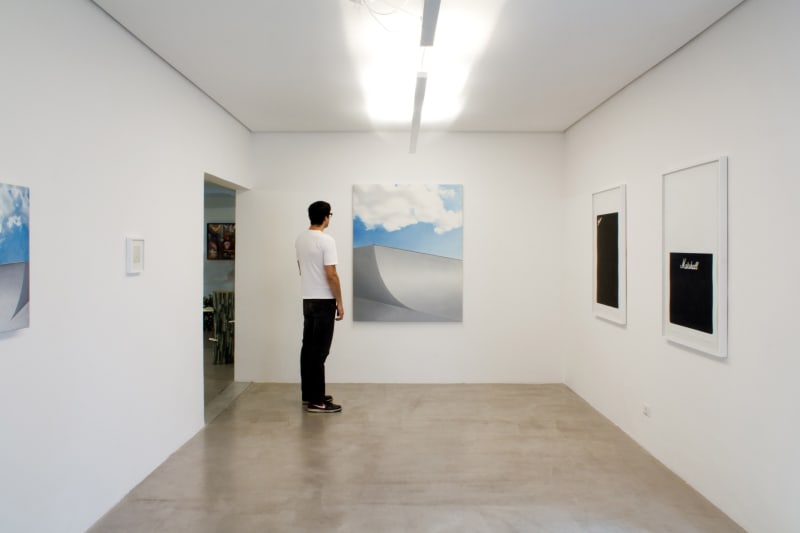Radical maneuvers
Where do the noisy and colorful figures adept to skateboarding, who could be the focus of the series Aéreos, new production by São Paulo native Fabio Flaks, now a sporadic skateboarder himself, wander about? When we see the canvases the artist produced on the subject, the absence of the typical "tribal" uproar seems to link these paintings more to the contemporary malaise of the protagonist in Paranoid Park (2007), by Gus Van Sant - a film in which the character Alex (Gabe Nevins) conceals a crime that is somewhat brutal, somewhat involuntary, that he committed while leaving a skate ramp -, than to the more countercultural and libertarian character seen in the sport by most.
Nevertheless, this less optimistic stand is consistent with Flaks's poetics, having emptiness and the crisis of representation as its two main vectors, aside from choosing the quotidian as one of his aims. Aéreos holds some resemblance to other works by the artist, such as the series Festa! (2009), in which the vestiges of what would have been a great confraternization, an hedonist partition, are perceived in their final stage as empty bottles serving as mere nuisance.The canvas When Routine Bites Hard (2006), which freezes a frame from the video of Love Will Tear Us Apart, by Joy Division, also draws links to Flaks's new phase, in suspending something idealized to be consumed with voracity - such form currently seems to divide itself between a medium with mainstream music industry superproduction status or a segmented vehiculation preferred by group accesses, which are becoming more and more exclusive, in sites such as YouTube - and, at the same time, pay tribute to the sad notes of the band that arose in the industrial Manchester.
The empty, grey ramps depicted by the artist are sketched as cut-outs of larger structures of the skate parks, urban-architectonic cartographies of concrete that point out São Paulo's and other large cities' leisure geography. They also create dialogues with common modern-brutalist buildings of the city, echoes of a desired idea of progress never completed. However, in formal terms, the external presence is an advancement in Flaks's production, characterized by glances fixed upon the interior. Above the ramps, the blue sky, with clouds of seductive shapes, breaks the symmetry of the construction undertaken by man, generating an interesting friction between the refined and the rational. The composition holds similarities with the Dutch school of landscape with names such as Vermeer (1632-1675) and Ruysdael (1628-1682), in which the panorama of cities is almost a pretext to the illustration of virtuous skies.
The precision undertaken in the painting of these heavens gains an interesting counterpoint with the sketches of amplifiers laid out by Flaks on one of the walls of the exhibition room of project Zip'Up. In these sketches there is the incessant and obsessive, nevertheless automatic, manual labor of the artist in filling in, via the lead of a pencil, the once permeable and pierced surfaces of the sound equipments. The brands presented - Fender, Marshall - evoke the power of consumption so much as they certify the emptying out of language, of speech. Bumbo is a particular work that was created using the same method, but in which the indicial methods, denoting vestiges, are stressed - the blank and empty areas serve as evidence to show how much physical effort was carried out in the piece.
In the exhibit Aéreos, as is easily perceived, Flaks avails himself of the diversity of visual languages to enhance the opacity of the images he creates. The engraving, at times questioned for some alleged fragile contemporaneity, is skillfully used by the artist, especially in Quicktimes. Such piece asserts Flaks's intention in making extraordinary one of the most trivial records, at least some years ago, in the computer culture. Today, it is a somewhat encyclopedic remain of procedure and imagery, at the time of its creation, tuned, avant-garde, edgy. "Nothing seems to be more universal in the current situation than the millenarian sentiment of end"(1), alerts Yve-Alain Bois.
Mario Gioia
1. BOIS, Yve-Alain. A Pintura como Modelo. Martins Fontes, São Paulo, 2009, p. 275

